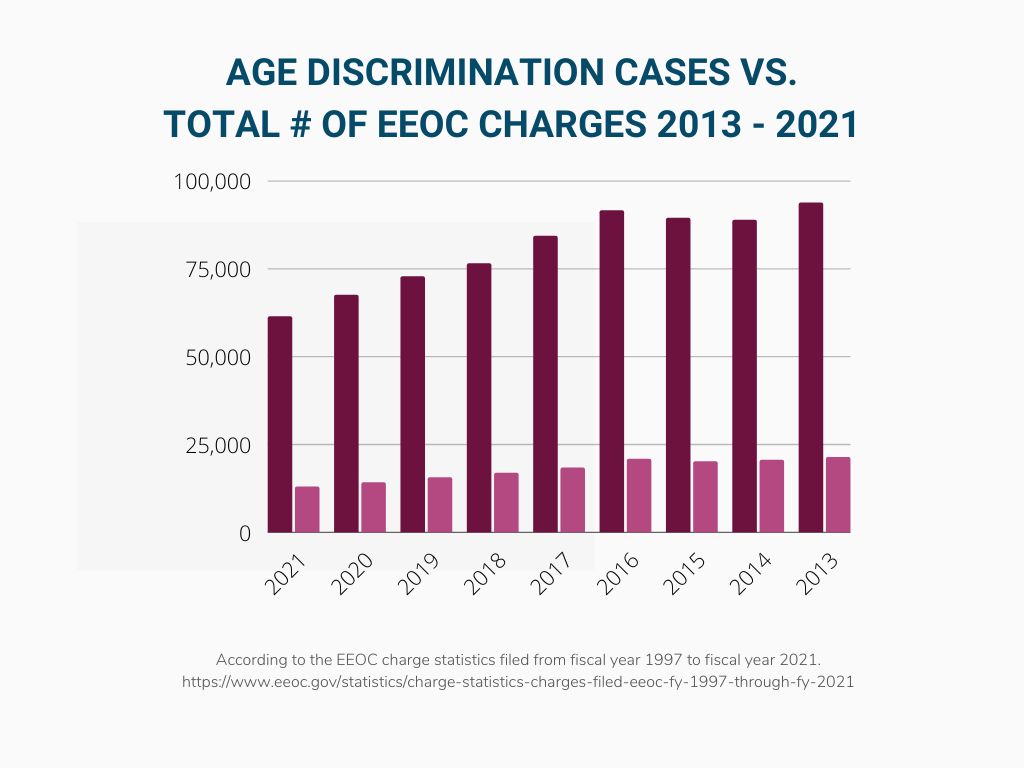How to Prove Age Discrimination at Work
Home / Our Services / Discrimination / Age Discrimination Attorney – Los Angeles, California / How can I prove age discrimination?
People fall victim to age discrimination every day in the workplace. This type of discrimination is so common that the People of California passed a law making it illegal to discriminate against employees just 40 years or older. You may be able to prove that your age motivated your termination if you take the time to document and gather relevant evidence.
Pay attention to whether an employer implements a policy that significantly impacts older workers and/or whether you are treated unfavorably in your senior years when compared to your younger counterparts.
Reach out for a consultation with an age discrimination attorney before you are fired. An age discrimination lawyer will work with you to identify relevant evidence. Most cases are proven with circumstantial evidence or some combination of circumstantial and direct evidence. Circumstantial evidence can be very powerful and must be given the same weight as direct evidence by a jury. An employer intending to violate the law is not always going to give you the direct evidence you need or admit to wrongdoing. Do not be discouraged.
Age Discrimination is Common in the Workplace
Every year, tens of thousands of age discrimination in the workplace are reported to the U.S. Equal Employment Opportunity Commission, making it one of the most common reasons for employees to experience discrimination in the workplace.

Proving Age Discrimination Happened to You
Here are some tips on how you may be able to prove you’ve experienced age discrimination at work:
Show that you are in the protected age class
You must be 40 years or older to be protected from age discrimination.
Prove that you were replaced by a significantly younger person
You may be able to learn information about your replacement through co-workers and/or during litigation. Sometimes employers will groom your replacement while you are still working. An employer’s claim that your position was eliminated may be disingenuous if your employer hires a substantially younger replacement under a different title.
Prove that a policy was implemented that detrimentally impacted and/or targeted older workers
This generally requires evidence of a pattern and practice and potentially statistical evidence.
Prove that younger employees of similar capabilities were treated better
It is not always necessary to show that you were replaced by a significantly younger person. California law is broad enough to safeguard you from discrimination in salary, employment benefits, or other terms and conditions of employment. It may be enough to show that younger individuals were given a promotion that you desired, retained in similar jobs, disciplined less harshly, or were otherwise treated more favorably.
Among other examples, an employer can indirectly impact your career trajectory by relegating you to undesirable assignments while passing coveted accounts or projects to your younger counterparts.
Prove that at the time of the adverse action, you performed your job satisfactorily
Faced with a discrimination claim, an employer will look for innocent excuses to justify its actions against you like portraying you as a poor performer. Keep records of good performance including performance reviews, accolades, and other metrics. Emails and/or texts commending you for doing a good job are also helpful.
An employer intent of getting rid of you might start to build a case of poor performance early by placing you on a performance improvement plan while creating obstacles preventing you from ever achieving set goals. Respond to undeserved criticisms so that your truth will also be included in your personnel file.
Prove your case with witnesses, “me too”/other victims, co-workers
If your employer discriminated against you, there may be other victims that you and/or your co-workers are aware of. While not every co-worker will have your back out of fear or intimidation, some are willing to speak the truth. Keep abreast of any witnesses during relevant interactions.
Prove your case with ageist comments at work
Intentions are revealed through actions such as adverse actions or comments. Document ageist comments and keep track of nearby witnesses. Even if there are no witnesses, a jury may believe you especially if you have other evidence.
Prove your case by reporting age discrimination
An employer’s refusal and/or failure to take remedial measures in response to a complaint of age discrimination may be evidence that the employer condoned the age discrimination. Complaining of age discrimination is akin to extending an olive branch intended to resolve the hostility.
Your employer has a legal obligation to prevent age discrimination by taking remedial measures. Contemporaneous complaints to family, friends, co-workers, medical providers are also relevant. If you are retaliated against for reporting age discrimination, you may have a separate claim for unlawful retaliation.
Prove your case by gathering evidence and documenting mistreatment
Most people never imagine they will end up in a lawsuit while dedicating most of their hours to their job. Take the time to build your own file.
- Document what is happening around you
- Although employers must respond to verbal and/or informal complaints, report violations in writing to prevent employer from denying notice of complaints
- Keep records of relevant correspondences and documents
This is not a complete list of all the ways to prove age discrimination. Each case must be evaluated on its own individual facts. Although gathering evidence requires time and effort, it is definitely worth it to seek justice for the discrimination you faced. You should also consider hiring an age discrimination attorney, like Employee Rights Attorney Group, to give you the best chance at winning your lawsuit. We look forward to speaking with you.